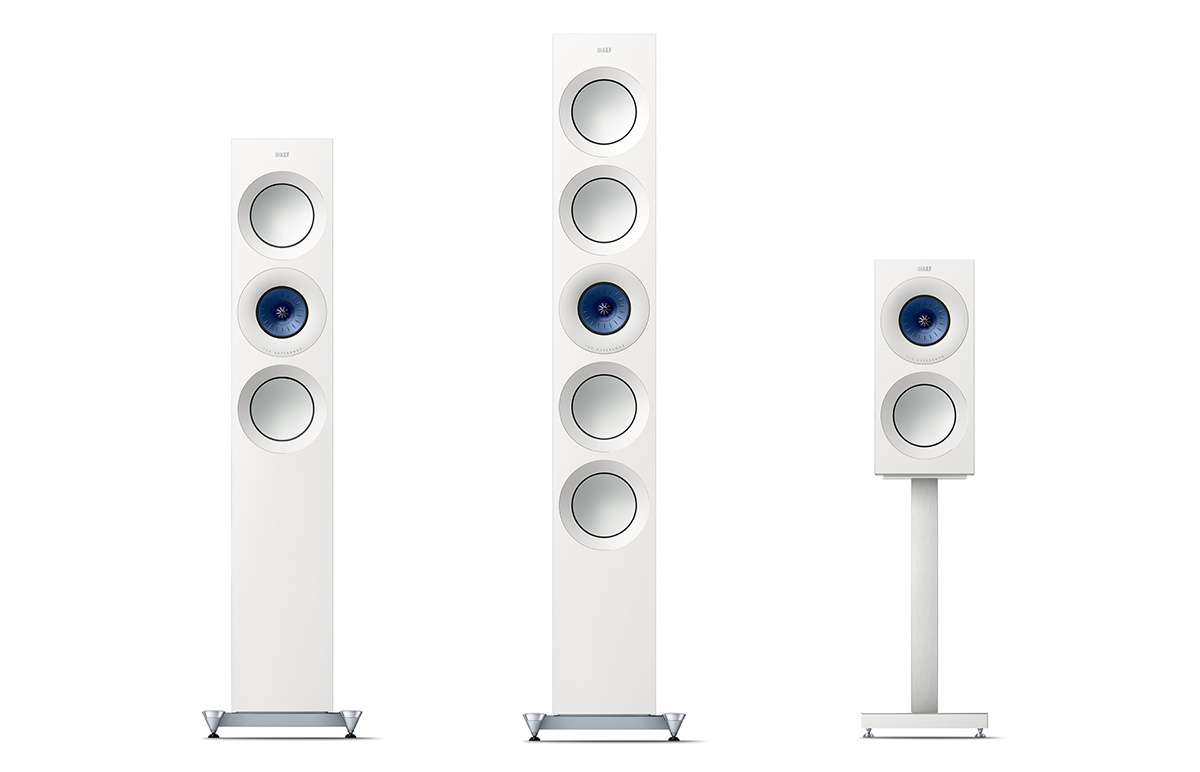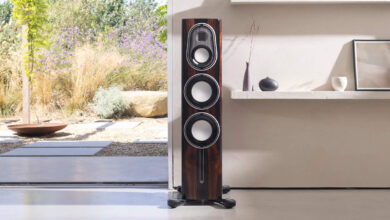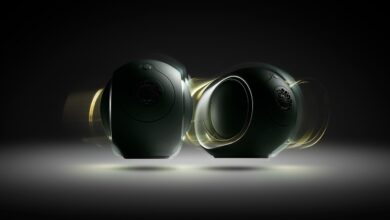KEF Reference 1 Meta loudspeaker Review
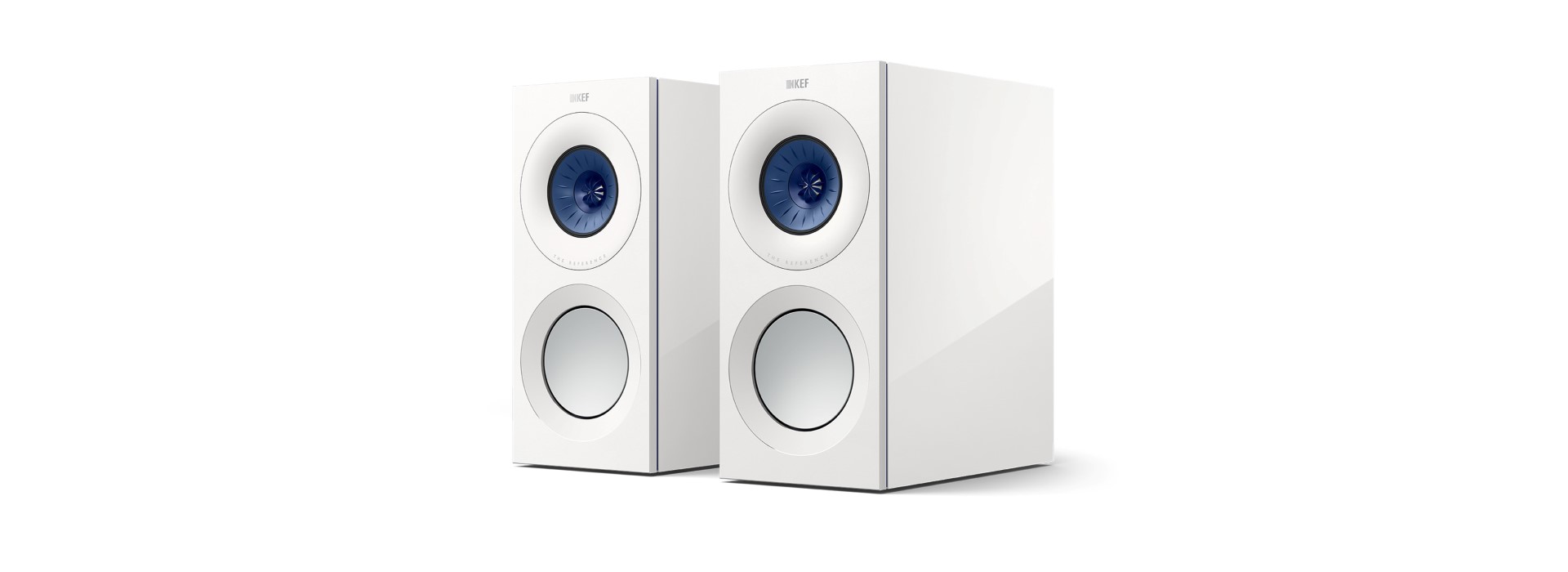
My Video Review:
When KEF announced their newest generation LS50 and LS50 Wireless II with Metamaterial Absorption Technology (MAT for short) that eliminated unwanted sound waves from the rear of the driver, for a purer and clearer sound…something was telling me that we’ll be seeing this technology on their higher end models at some point in time.
Sure enough, a year and a half later, KEF was retrofitting their Reference and Blade series with MAT, pushing their performance higher, while retaining the same minimalist look. A few months ago, I’ve wrote a story about how I’ve become a KEF Reference 3 owner, even if a smaller standmount Reference 1 was winking at me for quite some time. My story came just on time for their 60th Anniversary that celebrated 6 decades of thinking outside the box, giving freedom to hear music as your favorite artists intended. When opportunity struck to have a listen to their newest three-way standmount in the comfort of my home, I didn’t hesitate for a second and here we are. Reference 1 Meta boasts KEF’s 12th generation Uni-Q driver array with MAT, that according to KEF are capable of delivering expansive, high-performance sound that goes way beyond what its relatively compact size would suggest was possible.
While that sounds like good marketing material, after carefully listening to them for about three weeks, I can vouch for their ability to throw a gigantic picture, indirectly proportional to their cabinet size. At 40 lbs per loudspeaker, these are certainly the heaviest and the highest-performance standmounts I’ve had the pleasure of testing. Coming at £7.500 / €9.000 / $9.000 per pair, we’re looking at top-grade speakers, but are they worth it in the end? That’s the big question which I’ll try to answer today.
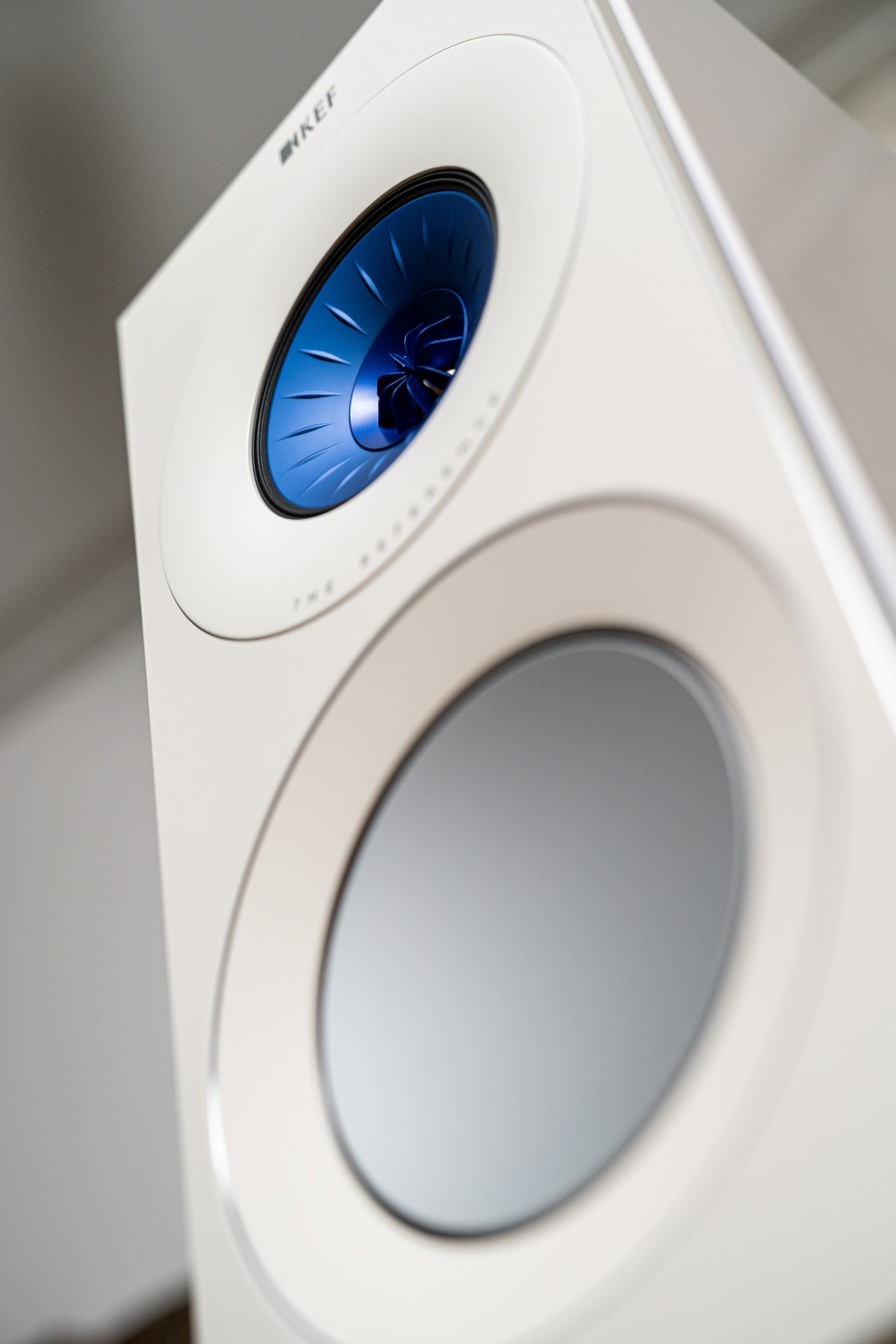
Build Quality & Looks
According to KEF, the Reference line is the physical embodiment of KEF’s Total System Design philosophy. Every component was optimized both within itself and as part of the whole, while every drive unit is given the chance to perform to the best of its considerable ability. The result is a loudspeaker that performs far beyond the sum of its parts.
KEF crafts most of their stuff in Asia, but their flagship series as Blade, Reference and Muon are all hand assembled locally in Kent, UK, exactly in the same building that was previously inhabited by Kent Engineering & Foundry, from which they’ve got their name. Since the company’s establishment, KEF has maintained a flair for unusual and controversial speaker engineering and design. KEF has always driven innovation in sound with examples, including its iconic Muon and Blade speakers.
As of right now, there are five Reference models: a three-way bookshelf speaker, two formidable three-way floorstanders, a three-way center channel and a powerful 1000W twin-driver subwoofer, which utilizes KEF’s ingenious force-cancelling technology. This configuration allows both drive units to operate more effectively, giving noticeably greater definition to lower frequencies.
The Reference Meta cabinets come in a choice of Satin Walnut & Silver, High-Gloss White & Blue (our review unit), High-Gloss White & Champagne, High-Gloss Black & Grey and High Gloss Black & Copper finishes. Their cabinets are expertly engineered to determine the ideal shape and bracing geometry and their structure minimizes both resonances from the cabinet walls and the effects of standing waves. With constrained layer damping techniques and massive internal bracing, the enclosures are virtually inert.
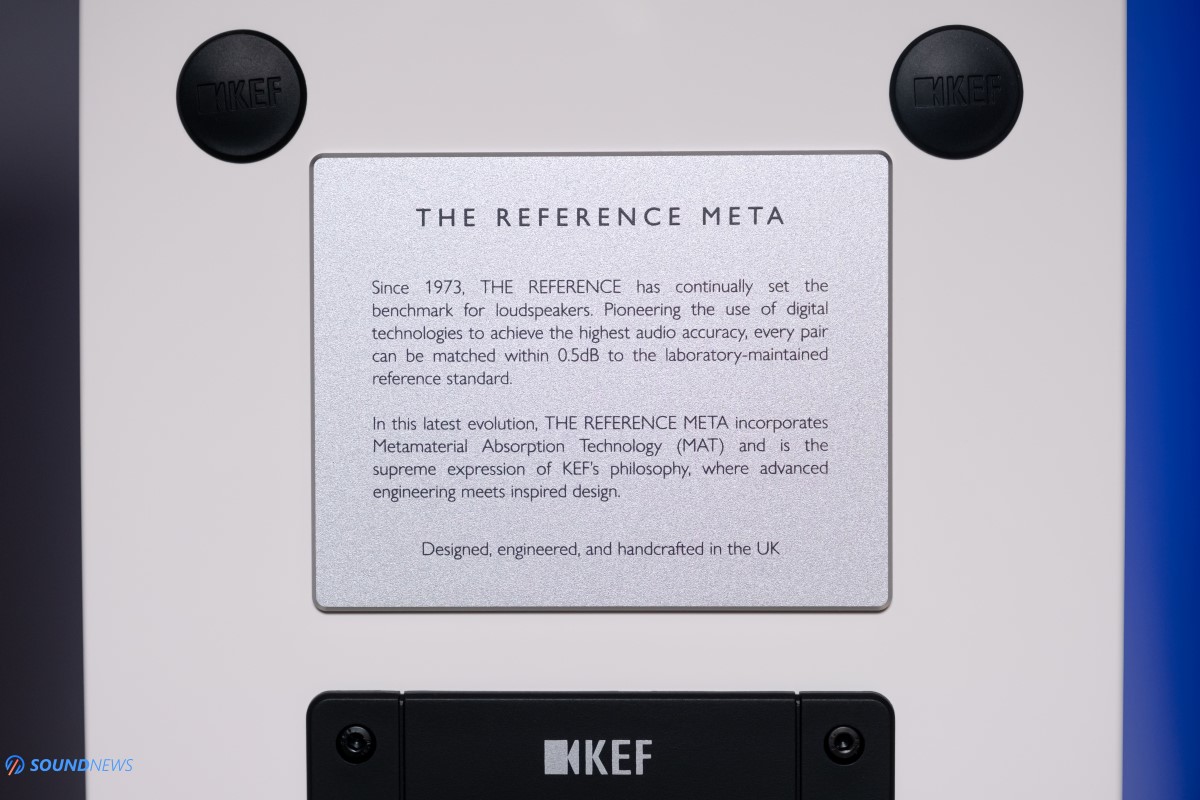
If you take a look at their front baffle, you can spot two aluminum plates sandwiched together, making the whole enclosure strong and rigid, nulling vibrations coming from their drivers. KEF ensures that Reference 1 Meta cannot generate resonances of their own, but if you want the last drop of performance out of them, nothing beats their dedicated S-RFI stands. Rocking a mounting system with integrated cable management, these were specially tailored for the Reference 1 Meta and if you’re already saving for the loudspeakers, you should add to the wish list their stands that will be nulling remaining vibrations.
Reference 1 Meta have platinum-plated brass speaker terminals that provide single and bi-wiring options. Weighting 18.2 kilos per speaker (40 lbs) and 8 kilos (17.5 lbs) per stand, this duo will turn heads and make a stunning first impression. These are the heaviest bookshelves that I used so far, serving an important purpose, as a heavier cabinet would null resonance, taking the advantage of reaction cancelling and that’s why their cabinets are made out of thick MDF boards, adding massively to their weight.
Last, but not least, I have a soft spot for white HiFi, as the biggest majority of my bookshelf speakers were white and you can already guess how I feel about these beauties. Spotting expertly engineered cabinets, finished in a high-gloss or richly detailed wood veneers to complement their front baffle, I find their fit and finish exceptional. I find them attractive; they exude a sense of high-quality and I must say that attention to detail is staggering on this one. As the entire Reference line, these are hand-made and you can feel that immediately after inspecting them closely. They look simple and straightforward, exactly how a proper high-end loudspeaker should look and feel.
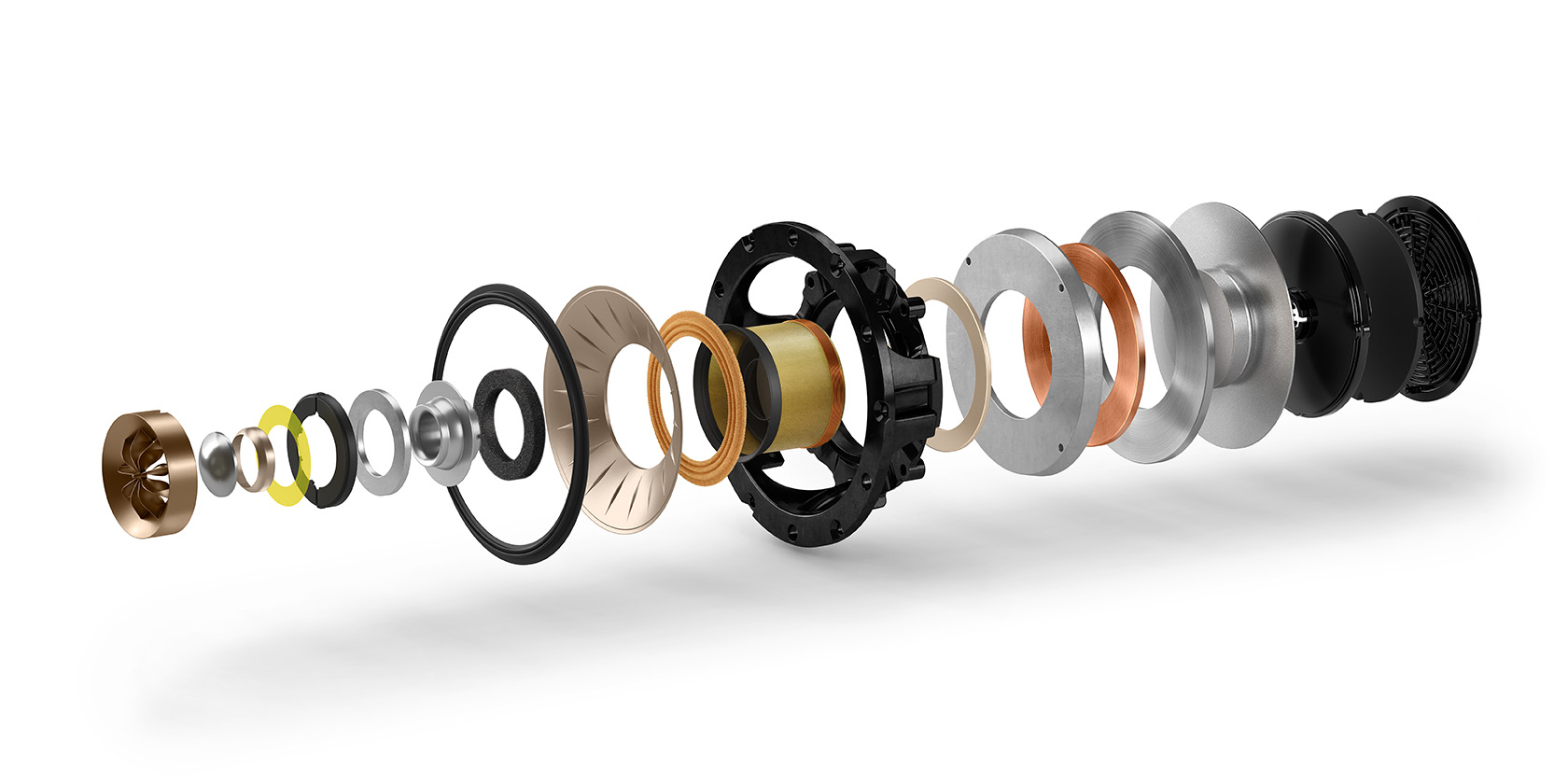
Technology Inside Reference 1 Meta
If you look closely there’s something distinctive with all KEF loudspeakers, starting with affordable ones and finishing with their best creations, usually it stays exactly in the middle of their cabinet, it’s rounded and protected from the outside world. I’m about their UNI-Q driver array that is currently at its 12th generation with the Reference Meta line. As its name states, it’s a unique 25mm vented aluminum dome tweeter that was placed at the center of a highly sophisticated 125mm midrange driver. Both act as a single source that floods the listening space evenly with a flawless, natural sound, no matter where you sit. The vented tweeter combines a powerful motor system with a unique computer-optimized two-part aluminum dome, so rigid that it operates pistonically over its entire working range. Its response has no trace of resonance or interference and the sensitivity is much higher to a conventional tweeter.

Obviously, not all UNI-Q drivers are made the same. For example, the one found in their LS50 Meta needs to deal with the whole frequency response, whereas the one found in the Reference line deals only with the midrange and treble regions, being helped by one or several woofers. What you are looking at is a huge midrange cone that uses a unique tangerine waveguide, naming it that way as when they were crafting it, a member of their team said that it looked like peeled tangerine pieces glued together. That midrange tangerine cone was firstly revealed with their Concept Blade that ultimately inspired the original Blade, that was released in 2011. That cone works as a waveguide and dispersion not only for the midrange region, but also for the whole treble range. In traditional loudspeaker design you have distinct points from where midrange and treble energy radiates, hurting the directivity of the waveguides in the process. KEF completely bypassed that issue with their UNI-Q arrays, as if sounds are coming towards the listener from a single inception point. They no longer need a complicated crossover that messes with the final outcome, as you have only two sources of sound radiation that can be seen as another substantial improvement. With traditional loudspeakers, sound waves can add up constructively, they can interfere with each other, adding distortion or nulling parts of the frequency response, but all that becomes a non-issue with KEF’s UNI-Q driver arrays.

A truly revolutionary tool with the newest Reference line is the new Metamaterial Absorption Technology (MAT) – a highly complex maze-like structure, where each of the intricate channels efficiently absorbs a specific frequency. When combined, the channels act as an acoustic black hole, absorbing 99% of the unwanted sound that comes from the rear of the tweeter, eliminating the resulting distortion and providing a purer, more natural acoustic performance. A result of joint development with the Acoustic Metamaterials Group, using MAT breaks completely new ground in loudspeaker design, and once again demonstrates KEF’s unrelenting passion for developing new technologies to improve your listening experience. Metamaterials are specially developed structures that use existing materials in such a way that they exhibit new, desirable properties that are simply not found in naturally occurring substances.

Reference line is also being helped by a few aluminum woofers. The new 165mm (6.5”) bass drivers are designed to perfectly complement KEF’s latest Uni-Q point source array. A massive vented magnet assembly and a large aluminum-wire voice coil are driving an exceptionally light, stiff and strong aluminum cone, for better dynamics and power handling. Reference 1 Meta have a single woofer per loudspeaker, mounted on their front baffle, just below the UNI-Q driver array. If you look closely, they have shallower aluminum drivers, allowing for a better diaphragm control, flowing freely in the air. Apart from that, each woofer is accompanied by a bass port to their rear. That’s right! Each Reference 1 Meta have a rear bass port that adds some oomph and rumble in the lowest octaves. By default, Reference 1 Meta are equipped with long ports, that are improving their low-end delivery and personally, I would use only their long ports regardless of your listening space. Still, you can swap them according to your preference and room acoustics.

Test Equipment
I wanted to know if I can alter their voicing with R-2R ladder DACs, improve their pace with modern Delta-Sigma DACs or have the best of both worlds with FPGA DACs and that’s why I’ve tried a dozen of units ranging from entry level devices to higher-performing units like Audiobyte HydraVox, Chord Dave, Gold Note DS-10 Plus and Denafrips Terminator Plus.
I’ve tried a few integrated and power amplifiers, starting with entry-level Class-D designs and finishing with top-tier Class-A/B and Class-A amplifiers, but most of my listening was made via a Topping LA90 integrated or via two Benchmark AHB2 power amplifiers used in bridge mode. Alright everybody, this is pretty much it, I’m ready for some well-deserved music, so let’s hit some eardrums!
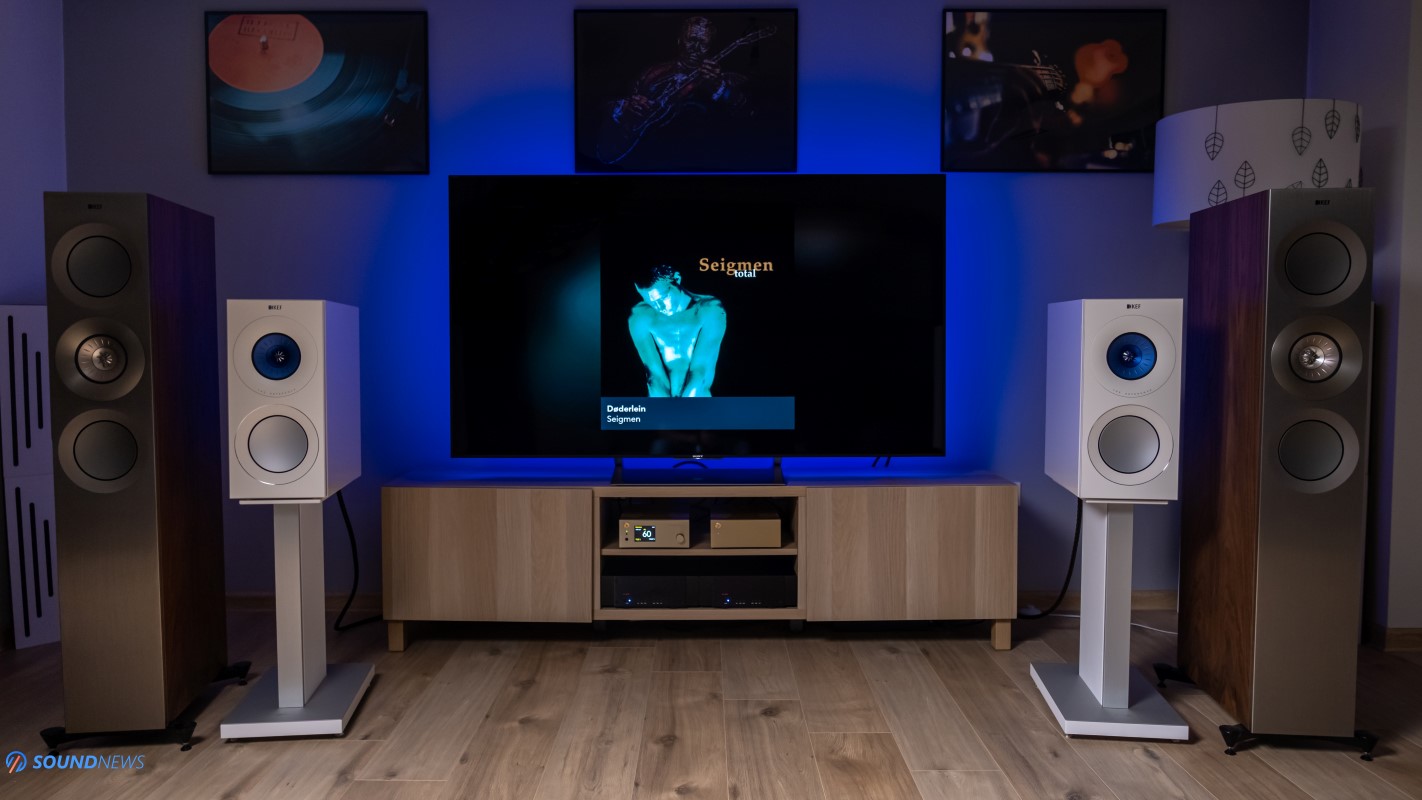
Sound Performance
I. Preliminary Sound Impressions
After coming back from the Munich High End Show 2022 (here’s my full report) I imagined that for two weeks I wouldn’t dare touching my loudspeakers, let alone listen to them…due to the brain damage we’ve experienced at the show. Covering ourselves in goose bumps eight hours a day, a few booths/rooms sounded way above our expectations, reminding us once again why we’re doing it in the first place. I’m sure for one thing though: I won’ forget the sound of the Borresen M1 bookshelves that were heads and shoulders above everything we’re tried at the show. While I was rocking hard and drinking ale in between listening sessions, my beloved was slowly cooking a pair of KEF Reference 1 Meta at home and after about three weeks, they were finally ready to be served. We calmed our spirits and sat down for a long listening session, sharing experiences with one another.
While considerably smaller to its bigger brothers, it struck me that at higher volumes, they sounded almost indistinguishable from my own Reference 3 standfloors. I’ve got the same see-through transparency, a nimble approach to music reproduction, but more importantly…these were still pushing and pulling crazy dynamic swings with pop and electronica tunes. For no reason, I started humming Born to be Wild by Steppenwolf (Qobuz / Tidal) as I see them as rebellious children that will play my songs their way. As a matter of fact, on Christmas day of 2020, I negotiated with Santa for a pair of Reference 1, as to my ears these were the most fun and engaging bookshelf speakers their local distributor had on display and mind you, there were even pricier speakers in their vicinity, but somehow my attention was drawn to the small KEF Reference loudspeaker. I was ready to pay respects to my wallet, when a kind gentleman asked if I wanted to give a shot to their bigger Reference 3 loudspeaker…and the rest is history. Reference 3 are playing for a year a half and couldn’t be happier with my purchase.
Before Reference 3, I’ve owned their LS50 and LS50 Wireless and I’ve tried on different occasions their newest and extremely popular R series of loudspeakers. People are still asking me on a regular basis, if the Reference line is any better to their LS and R series and how should I put it mildly? LS and R series are offering an outstanding sound per buck and I understand why people are into their sound signature. However, the Reference line has nothing to do with them, even if they carry the same family name. Everything went much higher, starting with transparency and finishing with tonal balance, speed and control of the drivers. While LS50 sounded good and R7 were great, Reference 1 Meta and Reference 3 were off-the-charts on all accounts, sounding like reference grade music making machines, in line with their name.
Going back to my loaner unit, I’ve experimented with a single versus two AHB2 power amplifiers and I definitely felt a livelier and a merrier sound in a dual mono configuration, getting machine gun like dynamics and a better low-end performance. My acoustic treatment is far from being complete and that’s one of the reasons at higher volumes, I liked the sound of Reference 1 Meta a little bit more. In regular living rooms with little to no acoustic treatment, I would definitely choose the little ones in detriment of their bigger and pricier offerings.
With usual bookshelves you’re sacrificing some low-end energy, for a more comfortable listen, but not with the Reference 1 Meta! Adding a time-aligned 6.5” high-performance woofer that sings in tandem with a 12th generation Uni-Q driver array, Reference 1 Meta weren’t lacking low-end definition and impact as KEF’s LS50 were doing without a dedicated subwoofer. I’m using their long ports which adds mass and air movement below 40Hz and even for an electronica addict as myself, I really don’t see the point in adding a subwoofer with the Reference 1 Meta, as their low-end delivery was more than enough in my listening room.
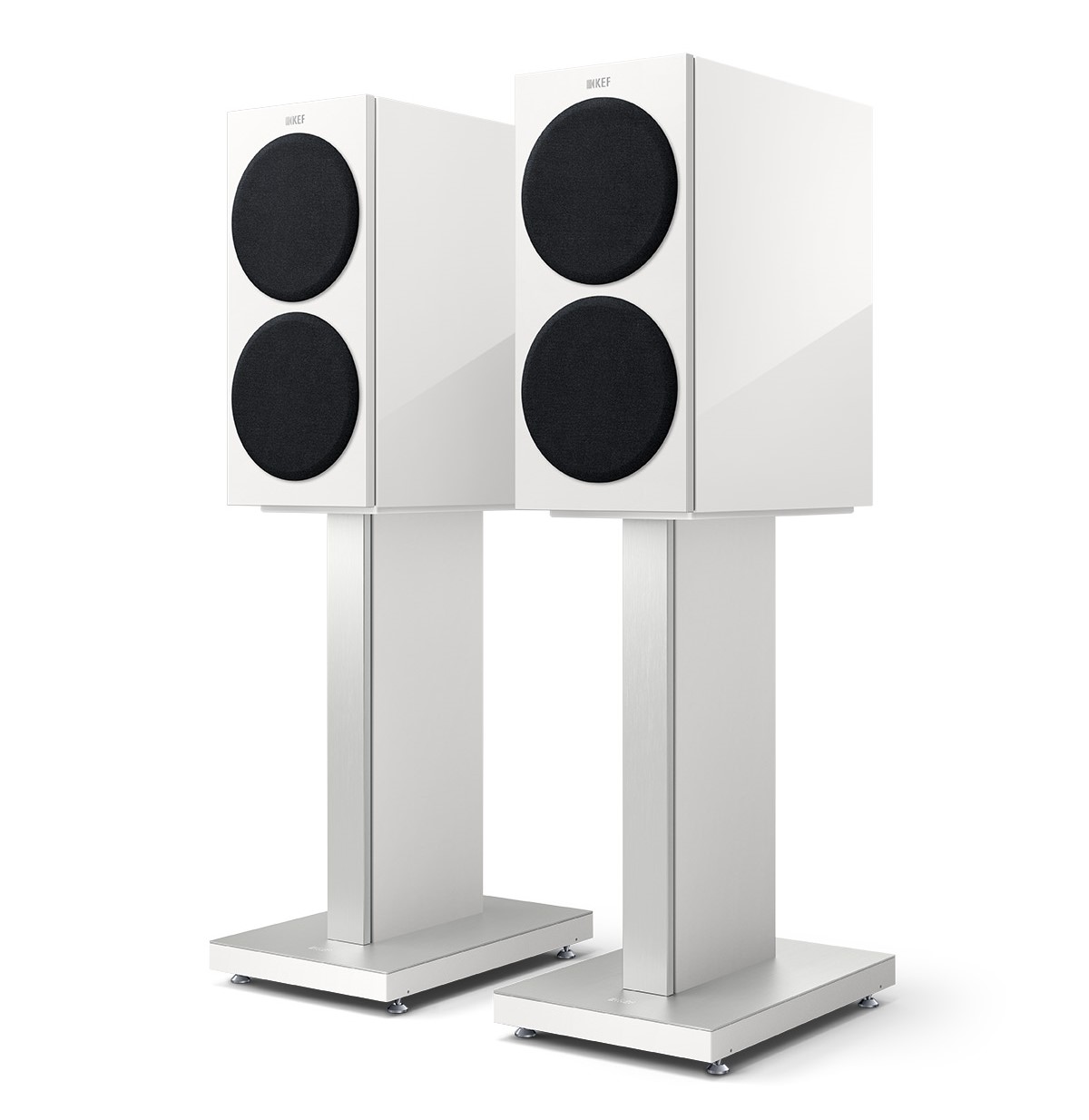
II. System Matching & Power Requirements
The Reference line won’t color your music in any way, that’s one of their strongest skills, but also their biggest downfall. Before you start panicking, do note that the same philosophy is found in world-best loudspeakers that will remove the cabinet and leave your music unchanged. With transparent sounding loudspeakers you can tune them to your liking with cold, warm, mellow or fast sounding down-stream equipment and that’s exactly what I’ve did.
I wasn’t surprised a single bit, getting an organic midrange with the Gold Note DS-10 Plus, a much thicker bass output with Denafrips Terminator Plus, a livelier sound with Burson’s Timekeeper 3i all-in-one and an overly-detailed & uber-transparent sound with two Benchmark AHB2 power amplifiers. Even digital and analog cables made a substantial difference – a clear sign that I was dealing with reference class loudspeakers. I wasn’t surprised by the final outcome, as my Reference 3 are sounding pretty much the same, with the exception that they hunger for more power, for a better control of the lows.
I’ve continued my review with the Gold Note DS-10 Plus that worked as a streamer, DAC and preamplifier, followed by two Benchmark AHB2, getting smoothness and liquidity from the Italian, transparency, speed and an iron grip over the drivers with American-made power amplifiers for the best results. Reference 1 Meta are sensitive to the source, source material, cables and amplification and you can bend their tonality to your will. While KEF recommends stereo amplifiers with a power output in between 50 and 200 Watts – Enleum’s AMP-23R with its 45 Watts per channel in 4 Ohms was driving them with aplomb, as I never raised its volume past 1 o’clock, leaving a ton of headroom for higher dynamic range tracks.
The only amplifiers I wouldn’t use with the Reference 1 Meta would be entry-level Class-D amplifiers of SMSL such as AO200, DA-8S, DA-9 and SA400 that were adding some hiss and hum, increasing the noise floor without music playing in the background. UNI-Q driver arrays are highly sensitive and for this reason alone I would skip entry-level and vintage amplifiers for good.
Clearly, your wallet and your imagination are the only limiting factors with the Reference line, as no matter how high you’re going with electronics, you’ll be squeezing a higher performance at every step of the way.

III. Soundstage & Depth
Moving on to soundstage and depth…but wait a second! Soundstage, in a bookshelf? Are you kidding me? Their tiny LS50 weren’t that impressive in here, barely filling the room with sounds at higher volumes. When I gradually moved to bigger and bigger bookshelves, as Buchardt S400, Sound Of Eden Crescendo UNO and Natural Sound N17, I felt that I was getting closer to the Reference 3 layering and airiness, as there wasn’t a massive gap anymore. It so happens that Reference 1 Meta are the biggest bookshelves I had for testing and unsurprisingly, they delivered the widest and the deepest sound from a pair of stand-mounted speakers. Filling every corner of my room with music wasn’t a challenge anymore and I wasn’t bound to live or classical music for that to happen.
While not as impressive at low-level listening as Reference 3 are, the little ones were still moving a substantial amount of air in a dual-mono configuration, that I completely forgot that Reference 1 Meta were playing in the first place. Since we’re dealing with a highly transparent and detailed sound, it was a child’s play focusing on the smallest intricacies that were passing nearby. While I can’t say that I’ve got a holographic and 3D picture in front of me, they were coming close to that kind of sound. What was plain and two-dimensional with LS50, transformed into a breathable type of sound, that was murmuring on all axes. Trailing low intensity sounds wasn’t an issue, but I’m sure the dual mono configuration gave a helping hand in there.
For no reason, I felt the urge listening to The Passenger by Iggy Pop (Qobuz / Tidal). Despite having a long-standing career, he is better known for his early masterpieces as this one. This tune isn’t a reference one when testing brand new speakers, but I do enjoy his non serviam style, like a twin brother to the rebellious Reference 1 Meta. Iggy was riding around my room, looking through the window so bright, it’s THE song that I always held as his most enjoyable and delightful to listen to. Fun fact: this song was composed while Iggy was riding the S-Bahn in Berlin, reminding me about long rides, but not so much about the act of traveling. This tune is about losing control of your life…as at that time he was struggling with drugs and alcohol addiction. Long story short, Iggy’s personality filled my room with thoughts and emotions, as Reference 1 Meta teleported me back in time with their realism, see-through depth and precise location of the notes.

IV. Detail Retrieval & Transparency
KEF’s LS and R series were already fun, dandy and pretty clean sounding, but the Reference line pushed transparency to much higher peaks, so much so, that I don’t see myself exchanging my beloved Reference 3 anytime soon. This is an important chapter, as if I won’t hear the smallest nuances surrounding my tunes, all the chit-chat playing in the background and the mastering errors of half-century old tracks, then I’ll be getting incomplete and unreliable results, that wouldn’t connect my inner self with the music that I know for a lifetime. By nature, metallic drivers aren’t resonating that much, they have a shorter travel in and out, they deliver a lower distortion at high SPL and as an added bonus these would be faster and more controlled compared to traditional (paper cone) drivers.
KEF’s knowledge and engineering skills went into the Reference line and it really shows when music starts playing. Be it Take Five by The Dave Brubeck Quarter (Qobuz / Tidal), Terracentric by Rodrigo y Gabriela (Qobuz / Tidal) or Hey Rise Up by Pink Floyd (Qobuz / Tidal), Reference 1 Meta were always pointing an invisible finger to the smallest details that were popping around those tracks. Imbued with Metamaterial Absorption Technology that eliminates unwanted sound waves coming from behind their drivers, Reference 1 Meta are now purer, more transparent and life-like sounding than ever before. Reference 1 Meta will show minuscule differences between sources and amplifiers, in some ways they can work as a tool when evaluating new gear, as finally DACs would sound so different. There were times when I was ditching the AHB2 in favor of less-revealing units that could improve their tonality and relax me a little. These won’t sugar coat your music, as I see them quite honest, staying true to the recordings and revealing as much information as they can.
A few years ago I was forced in using top-grade headphones when assessing new D/A converters, as my former loudspeakers couldn’t pick up the smallest changes in pace, rhythm, timing and detail retrieval, but that’s no longer the case with the Reference line, that provides a healthy amount of micro and macro-detail, without stressing the listener.
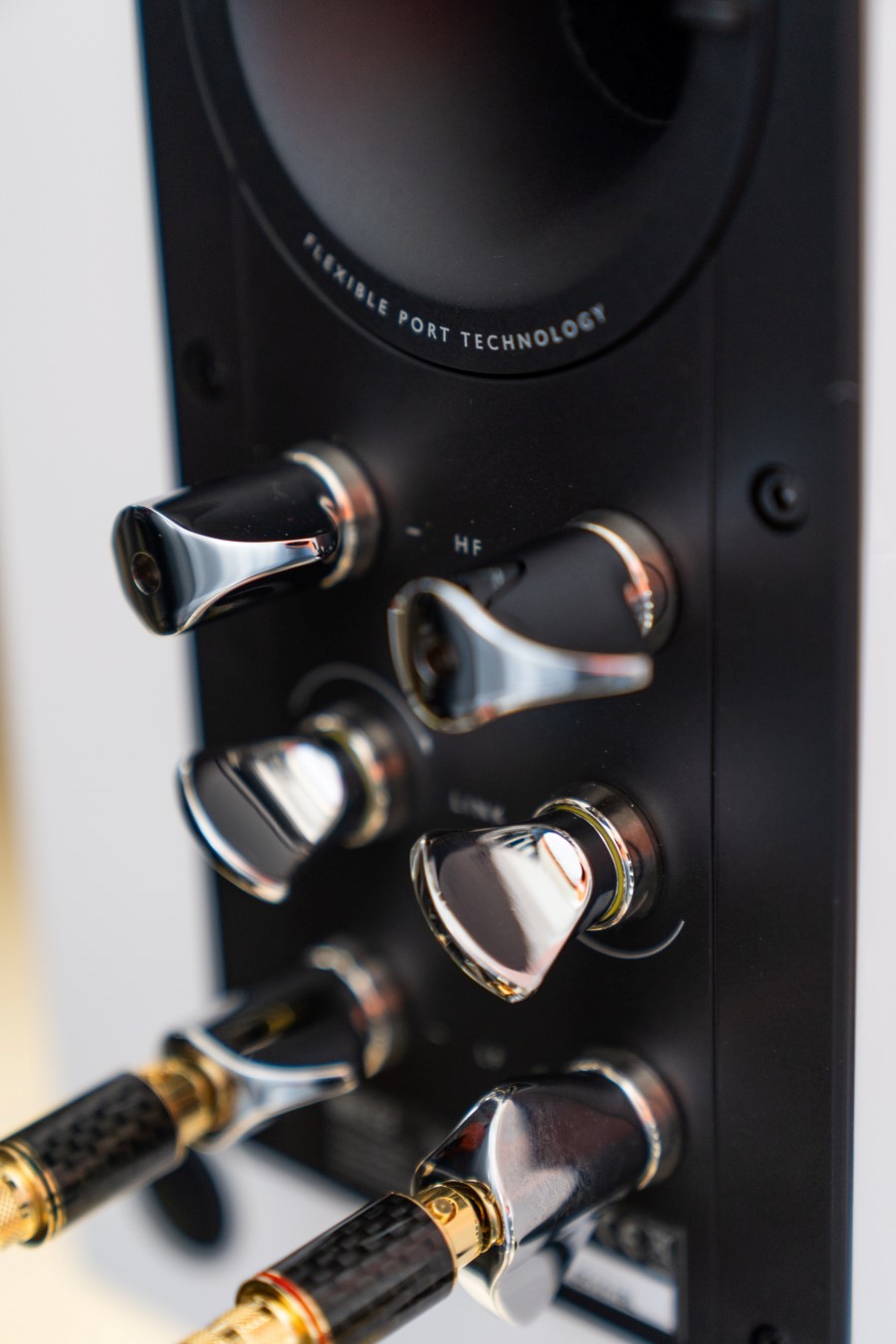
V. Transient Response
After having a trip to the Munich High End Show, listening to hundreds of speakers in a span of three days and then coming back home, I’ve realized that Reference 1 Meta are still fiercely holding the door against pricier offerings, especially when it comes to transients. This is one of the (biggest) reasons I’ve got the Reference 3 in the first place, as I really like their way in dealing with fast and impactful tunes that take a big portion of my audiophile diet. I want my loudspeakers to be equally impressive with mellow & lightning-fast tunes, I want them to accelerate and decelerate instantaneously if the music is asking for it. Speaker manufacturers are constantly trying new materials when forging their drivers, ranging from paper, wood, plastics, rare metals, even diamond coatings, but it seems that only stiff / rigid drivers can go in and out in split seconds, delivering instant decays when music asks for it. Horn-loaded speakers have their magic with blues and jazz, especially when hybrid amplifiers are driving them, electrostatic loudspeakers are unbeatable when it comes airiness, layering and sheer scale of the music – directly proportional to their size, but traditional closed-cabinet loudspeakers can be special too, thanks to a fast motion of their drivers. I’m swapping my playlists depending on the mood and to what comes around my life and that precisely why I’m not fond on loudspeakers that will sound slow but never fast, or on the ones that will sound big but never cozy. I like when speakers are down shifting or increasing their tempo, change their scale and that’s probably why I’ll be sticking to traditional loudspeaker designs.
If something will be pressing the brakes in terms of dynamics, then I won’t get goose bumps and I won’t toe tap my feet. Luckily, Reference 1 Meta are walking the same path paved by their bigger brothers, so you can expect them to be smooth and relaxed with jazz & blues and lightning fast with electronica & rock tunes. Mongol warriors of The Hu didn’t scare them away and never slowed them down with the newest This Is Mongol EP (Qobuz / Tidal). In my view, the Reference line was specially tailored for modern music. Be it pop, hip-hop, rock, electronica and all their sub-genres, these were always injecting a healthy dose of dopamine, always knowing how to put a smile on your face. Give them space and time to form, give them high-quality juice and behold dynamics jumping off your walls. With all due respect to bookshelf speakers that were tested around here, these are taking home the Gold medal if we’re talking about transients.

Frequency Response
VI. Bass
If you check my bookshelf speaker reviews, then you’ll observe that I complained about their shy, almost ethereal low-end performance that was barely reaching the lowest octaves. Passive radiators of Buchardt S400 and Sound Of Eden Crescendo UNO brought a much needed bass extension, but all that energy wasn’t channeled at hitting my chest directly. In the end, I was hearing a good bass performance, but I wasn’t feeling its physical manifestation. Speaker designers always struggled in providing air mass down low, as a smaller cabinet & woofer size and a lower number of bass drivers can’t do wonders. We are still surrounded by physics and their laws. While, Reference 1 Meta won’t outperform proper standfloor speakers, they were the closest ones to the sound of the bigger Reference 3. Finally, I could hear and feel bass notes hitting me frontally, sending my right foot into a toe-tap fiesta. Obviously, these won’t reach 20 or 25Hz notes, but there is some driver moment in between 30 and 35Hz that adds some oomph and rumble. What I like the most about the Reference line is that they won’t charm you with quantity, but mostly with bass quality. On the right setup, bass felt playful and punchy, but also clean and distortion free. If you never heard bass authority with small bookshelf speakers, then Reference 1 Meta will put that on display so bravely. There’s a substantial jump in low-end quantity & quality to my former stand-mounted speakers…and that is perfectly fine, since Reference 1 Meta are the highest priced stand-mounts I’ve tested so far.

VII. Midrange
As their name suggests, KEF tunes their loudspeakers with a reference tuning, going for a linear frequency response without highlighting any region more than it needs to. There’s a smooth transition from upper-bass to lower-midrange, even if their crossover frequency sits higher than usual at 450 Hz. Going by the rule of thumb, aluminum woofers shouldn’t resonate with wooden instruments and yet, I didn’t experience an emotionless, thin or dry sounding midrange. These guys aren’t playing around, hiding cheap components below beautiful finishes, as some of the magic happens on the inside. I would describe them as having just a splash of warmth and naturalness, without overdoing it as horn-loaded loudspeakers are doing by default. There’s a balance between being tonally correct, tactile and organic sounding. I wouldn’t describe them as soul-grabbing or mid-centric as I would do with upper class Dynaudio, Dali or Spendor loudspeakers, as KEF went with a more neutral tuning, focusing more of technicalities as speed, impact and cleanness. If you’re after an absolute relaxation of body and mind through a mellow and delicate midrange delivery, then Reference 1 Meta won’t do that with solid-state amps. On a positive note, you can alter their character pretty easily, they can render a sweeter midrange and you can definitely add some weight and substance to your music. Nothing does it better as a full-tube or hybrid amplifier, pushed by an all-discrete Class-A preamplifier that’s connected to a well-made R-2R ladder DAC.
Even without walking the vacuum tube path, there is enough midrange presence that preserved the pitch of the human voice. Musical instruments still carried emotions and I could easily discern their wooden bodies, their strings wept and dragged me into a musical wonderland, but those weren’t vibrating as long, due to a quicker decay of the notes. I felt authority with male vocals and sweetness with females, reminding that Reference 1 Meta can still highlight their beauty. All in all, I didn’t long for my former Dynaudio loudspeakers, as Gold Note DS-10 Plus was already adding plenty of warmth, that worked well with the Reference 1 Meta.

VIII. Treble
The Reference line will impress you right away with its clean and transparent treble delivery. Even at much lower volumes, you can hear the sparkle and tiny air movements in the room, adding to the immersion of being surrounded by music and not by mere sounds. It is quite impressive that even at 55dB I’m getting the shimmer of tambourines and ringing of bells. In my humble opinion, these excel at everything that has to do with treble, starting with treble extension and finishing with the top octave that never felt rolled-off. One of their hallmarks is treble extension, as I’m yet to hear a truer to life treble performance at this price point. I have a thing with drums dating back to my university years, as my subconscious is constantly searching for a pair of loudspeakers that would remind me of my drum kit. I wanted a razor-sharp precision, a perfect timing and the right pitch of tambourines, bells and snares and it seems that the Reference line is doing it pretty easily. I’m no longer searching for a different loudspeaker, as I’ve got everything a treble head would ever desire. Reference 1 Meta are not only on the same level with the Reference 3 in here…but maybe a little better due to Metamaterial Absorption Technology that nulls distortion at higher volumes. The good thing is that even with dead-neutral amplifiers like AHB2 by Benchmark, I didn’t get overly sharp leading edges to a point of becoming bothering. Reference 1 Meta were still tightly controlling the treble output and I didn’t get bright or cold sounding. One thing I’m sure of: Reference 1 Meta are crispier and cleaner sounding to my former bookshelf speakers, covering the widest frequency response I’ve experience with such designs.

My Conclusion
After trying ridiculously expensive rigs at the Munich High End Show 2022 and coming back home, I realized that KEF Reference 1 Meta aren’t that far off performance wise, even if they won’t cost you an arm and a leg. I truly enjoyed my time in their company and they were exactly as I have envisioned a smaller Reference loudspeaker should look and perform. Neutrality and high-levels of transparency are their key selling points and if you’re curious about the limitations of your setup, then prepare for an upgrade. Every small system change will feel like a small victory and bigger changes will feel like swapping speakers altogether. Besides listening to a bunch of tunes, I also watched a few movies with them and I’ve got a similar belly-slapping transient response and low-end delivery of their bigger brothers.
Having a good tonal balance, system matching wasn’t a big deal, as even dead-neutral amplifiers were snappy and engaging sounding, even affordable ones like Topping PA5 and LA90 performed above my expectations…but they’ll definitely sing nicer tunes with power-overwhelming amplifiers. Feed them clean power, use a revealing source and watch them go wild on dynamics and spread their wings with live-recordings. The biggest complement I can give is that there wasn’t a musical genre that didn’t sound great on them and that’s why our highest Gold Award was fully deserved.

KEF Reference 1 Meta will cost you £7.500 / €9.000 / $9.000 per pair and you can get them from your local KEF distributor. I want to thank the Avstore.ro team for lending me a pair and for answering my questions. If you are getting a pair or you just returned from a listening session, please leave a comment below and let me know what sources and amplifiers worked best for you.
PROS:
- Stylish and timeless looking…these will be turning heads
- An excellent fit & finish
- Weighty for their size, adding confidence that I’m dealing with a high-quality speaker
- A future-proof loudspeaker, Metamaterial adds a lot of value
- Once a proper amplifier drives them, expect sub-bass notes paying you a visit
- Impressive transients, pace, rhythm and timing!
- Their sound staging capabilities were above my expectations, delivering an airy and well-separated sound
- Honest & detail-oriented above anything else. These will be revealing the bottlenecks of your setup
- Tries to cover frequency response in full, even if they can’t reach the lowest octaves.
- One of the nicest treble I’ve heard on a loudspeaker – it was just right from the get go
- Linear and neutral (in a good way), without sugar coating your music
- Refined and fun sounding
- Acoustic treatment isn’t mandatory, but they will benefit from a fuller/busier room
- Yes, they are worth their asking price
CONS:
- They dislike noisy entry-level amplifiers & noisy downstream equipment in general
- They do like some power, diesel power
ASSOCIATED EQUIPMENT:
- DACs: Denafrips Terminator Plus, Rockna Wavelight, Audiobyte HydraVox & HydraZap, Chord Dave, Gold Note DS-10 Plus & PSU-10 Evo, FiiO K9 PRO ESS
- DAPs: Hiby RS6, R5 Gen2, FiiO M17, M11 Plus ESS, Shanling M7
- Headphone Amps: Trafomatic Primavera, Enleum AMP-23R, Ferrum OOR + Hypsos, Flux Lab Acoustics Volot, Burson Audio Soloist 3X GT, several Topping, SMSL & Gustard units
- Preamps: Musician Monoceros
- Integrated Amps: Enleum AMP-23R, Burson Timekeeper 3i, Topping LA90
- Power Amps: Benchmark AHB2 (x2)
- IEMs: FiiO FH9, FH7, FA9, FD7, Meze Rai Penta, LittleDot Cu KIS, Kinera Skuld, 7Hz Timeless &others
- Full-sized headphones: Hifiman Susvara, HE1000SE, Arya Stealth, Audeze LCD-5, LCD-4, Erzetich Phobos V2021, Phobos V2018, Erzetich Mania, Kennerton Rognir, Magni, Gjallarhorn, Vali, Apos Caspian, Sendy Peacock, Apollo, Aiva & others
- Loudspeakers: KEF Reference 1 Meta, KEF Reference 3, Sound Of Eden Crescendo UNO, Natural Sound NS17
- Interconnects: QED Reference (x2), Topping TCX1 (x2)
- Speaker cables: Kimber PR8, Audioquest Type4
- Power Cables: Isotek EVO3 Premier (x3), iFi Audio SupaNova (x2)
- Balanced Isolation Power Conditioners: PLiXiR Elite BAC1500 (stereo setup), Elite BAC400 (headphone setup)
